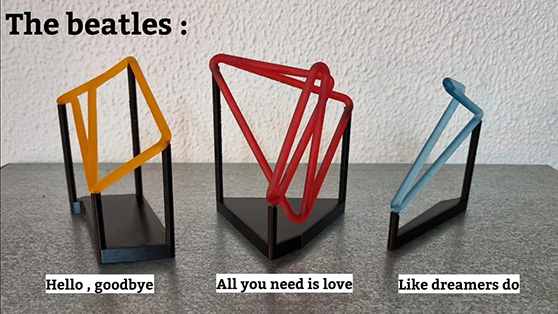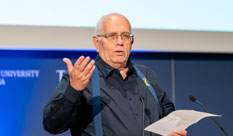More:
News & Stories
Q: WHAT DO THE BEATLES AND GEOMETRY HAVE IN COMMON? A: LOTS OF CURVES
Applying geometric principles to music is not a new phenomenon. From as far back as the 5th century BCE, the Greek philosopher Pythagoras believed that numbers could explain everything, and that mathematics could guide our interpretation of the universe.

Dr. Shai Gul, from the School of Applied Mathematics, studies the geometry of curves and surfaces – a branch of mathematics known as Differential Geometry. By applying these principles to the vibrational occurrences in music – more specifically, to the three-note chords known as triads, Dr. Gul was able to ‘translate’ them onto the physical plane by mapping its chords onto a three–dimensional structure. - what he called “characterizing music as a tangible entity’.
The goal of the study published in the journal Mathematics 2023, 11, 4398, is to enable music novices to gain insight into the complexity and intricacy of a song, while offering professional musicians a new visual perspective and a tool to evaluate the complexity and dynamic of their compositions.
Using Beatle songs as its subjects – “Across the Universe”, “Get Back”, “All You Need Is Love”, and “Ask Me Why”, among others - a ‘total curvature’ approach to the sequence of triads, as represented through curves, was applied within a physical space which reflected the twelve possible pitches or tones of Western music. As a result, a technical model was devised utilizing curves to represent the chord progression, with its vertices acting as coordinates. The model, in the shape of a polygon curve, offered insight into both its mathematical and design perspectives, strengthening the connection between the two. This is one of the first times ever that a 3D geometric representation was devised and applied with any accuracy and consistency, contributing significantly to the bridging of mathematical concepts and design considerations.
In the application of the mathematical formulae that he devised to physically create a 3D geometric object representing the chords of the Beatles songs, it was demonstrated that two songs which, to the ear, contained similar harmonic choruses in fact were visually different in their 3D depictions. So, while “Across the Universe” and “Ask Me Why” had similar choruses, they are, in fact, distinctly different from the curve perspective. So, too, the mapping of the 3D objects demonstrate different things for different users; for the non-professional, they see a simple triangle; for the professional, they note the curves wrapping about the triangle, the direction of the sequences, their proximity, etc. – all providing unique insight. This singular way of interpreting music allows the listener and composer to better understand and analyze the complexity of the piece – each one at their own respective level.
The methodology used in this study examined not only the number of chords defining the song, but also their sequence, thereby demonstrating the pattern and movement of the curve. In many cases, this highlighted a similar sequential series of chords in a specific key. By viewing their compositions in physical format, the composer can observe or manipulate the number of loops (chord repetitions) and the direction of the curve (chord progression), ultimately enhancing and further developing their artistic expression and inspiring cross-genre possibilities.
Dr. Gul’s interest in applying geometric models to creative enterprises is an ongoing focus of his work. In 2021, he established a multidisciplinary research laboratory on the HIT campus, dedicated to studying the interface between design, computer science and mathematics.
- News & Events
New Collaboration with Sheba Medical Center will qualify nurses to work in a digital environment.
Collaboration between HIT Holon Institute of Technology, the teaching authority of the Sheba Medical Center, and the Sheba-BEYOND virtual hospital will allow training nurses in Israel and around the world to work in a digital...



 Additional programs
Additional programs
